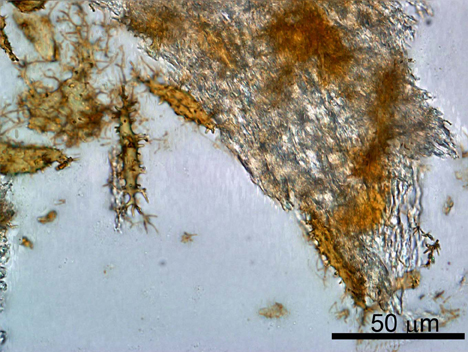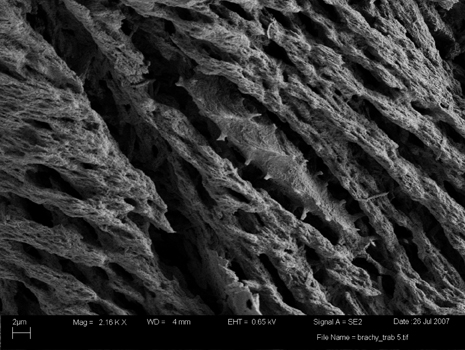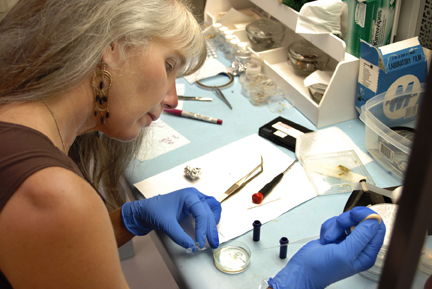
by Brian Fisher Johnson Thursday, January 5, 2012

Multiple _B. canadensis_ red blood cells surrounded by a white, fibrous matrix. Image courtesy of Mary H. Schweitzer

A scanning electron microscope image of demineralized _B. canadensis_ bone matrix. Image courtesy of Mary H. Schweitzer

Mary Schweitzer working in the Imaging and Chemical Analysis Laboratory (ICAL) at Montana State University in 2007. Image courtesy of Kelly Gorham, Montana State University
A two-year-old debate is back in the flesh — literally.
Molecular paleontologist Mary Schweitzer of North Carolina State University in Raleigh and colleagues presented evidence this week in Science that they had successfully recovered and identified collagen, a type of protein, from the femur of an 80-million-year-old hadrosaur, a duck-billed dinosaur.
Just two years ago, Schweitzer and colleagues stirred excitement and controversy when they announced that they had successfully recovered collagen from a 68-million-year-old T. rex femur. Previous research had suggested that soft tissue could not survive longer than a million years. But that original collagen was also found in the hadrosaur, called Brachylophosaurus canadensis, confirms “that molecular preservation in Cretaceous dinosaurs is not a unique event,” Schweitzer’s team wrote.
Like the T. rex proteins of 2007, the B. canadensis findings were the result of multiple tests. Treating the bones with acid revealed features in the bone fragments that resembled blood vessels and bone cells, while further examinations seemed to confirm that those tissues were from the dinosaur. For example, the tissues reacted with antibodies sensitive to collagen, a relatively durable protein universal among higher forms of life such as mammals and reptiles like the dinosaurs.
The team then compared recoverable sequences of the collagen with those of living animals. The proteins, they found, were more similar to living birds than alligators, supporting the idea that the collagen was original to B. canadensis.
Despite this evidence, which the authors say “strongly supports” the original nature of the collagen, Schweitzer says she anticipates a repeat of the controversy that surrounded her 2007 report on T. rex: Some scientists challenged, for example, whether Schweitzer’s team had found actual tissue or a bacterial film that merely resembled the cast of tissue.
But “what really bothers people is: Why the heck is this stuff there?” Schweitzer says. “A lot of people aren’t willing to accept the data until we come up with a mechanism for preservation … We’re not there yet. All I can say is: Here’s what we see, here’s what we’ve done, and here’s our results.”
Tom Kaye, a paleontologist at the Burke Museum of Natural History and Culture in Seattle, Wash., was one of the scientists who suggested the bacterial film explanation after the T. rex study — and for similar reasons, he is unconvinced about the hadrosaur results. Following the T. rex study, for example, Kaye and some colleagues searched for preserved proteins by surveying a range of separate Cretaceous bones with a scanning electron microscope. They concluded in a 2008 PLoS ONE paper that Schweitzer's team had very likely found a bacterial film that looked like a cast of the T. rex tissues — not original tissues — because the molecular make-up of the cast showed more similarities with modern biofilms than the presumed bone "tissues."
Schweitzer, however, contends that bacteria do not produce collagen, so the fact that her team did find the protein in T. rex and B. canadensis rules out a bacterial cast.
She says she welcomes the criticism — and, in fact, hopes her team’s work spurs other scientists to do their own analyses. “Were trying to hold ourselves to standards that are appropriate and trying very hard in our writing not to overstate our data … My colleagues, when they hammer this paper, they’re doing their job. We’re paying them to be skeptics.”
© 2008-2021. All rights reserved. Any copying, redistribution or retransmission of any of the contents of this service without the expressed written permission of the American Geosciences Institute is expressly prohibited. Click here for all copyright requests.